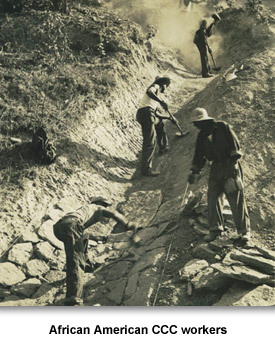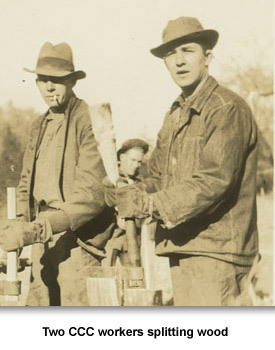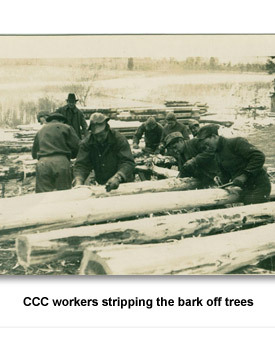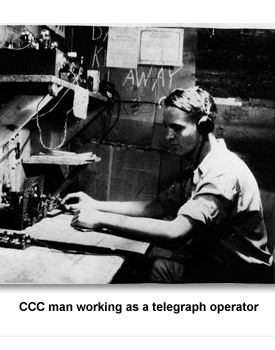For Workers
The Great Depression cost many Tennesseans their jobs. For example, one out of every four workers in Nashville was unemployed by 1930. In 1932, 578 Tennessee businesses closed, leaving their employees without jobs.
During the first years of the Depression, Americans disagreed about who was responsible for helping unemployed and other needy people.
President Herbert Hoover and his supporters thought local governments and communities should be responsible for relief.
Over time, increasing numbers of Americans came to disagree with this idea. One of Tennessee’s congressmen, Rep. Joseph Byrns, opposed Hoover. He said that:
The pressure on the federal government to provide relief continued to increase. Finally in July 1932, President Hoover signed an act that created the Reconstruction Finance Corporation to provide jobs for unemployed people.
In Tennessee, this program provided jobs for 65,000 people at its height. Most of the people worked on road construction projects.
CCC Jobs
Under Roosevelt’s New Deal, many more jobs were created in Tennessee under several public works agencies. Beginning in 1933, the Civilian Conservation Corps (CCC) provided jobs, mostly for young men. The CCC established camps near worksites.
By 1935, there were 77 located in the state, and the CCC employed thousands of Tennesseans. CCC workers did jobs like building five Tennessee state parks, planting trees, and working on soil conservation projects.
The CCC provided many lasting benefits to Tennessee. However, this agency experienced some controversy. It was criticized for discriminating against African Americans who applied for jobs. The CCC’s camps were segregated. Many Tennessee communities didn’t want a camp for African American CCC workers located near them.
CWA Jobs
The Civil Works Administration (CWA) was a short-term program designed to help the unemployed get through the winter of 1933 to 1934. In Tennessee the CWA provided jobs to over 50,000 people who worked on 1,150 different projects. Many people in this program worked on roads or community buildings like schools.
PWA Jobs
The Public Works Administration (PWA) was created under the National Industrial Re-cover-y Act of 1933. The goal of this program was to provide jobs and stimulate business, and it included many different kinds of projects.
PWA projects included road building and repairing, and constructing public housing, schools, and hospitals. For example, in Chattanooga, PWA workers built seven schools and enlarged the local hospital and county courthouse. In Nashville, PWA workers built the Tennessee Supreme Court Building.
WPA Jobs
In 1935, President Roosevelt proposed combining the work relief efforts into a single agency, the Works Progress Administration (WPA). WPA workers in Tennessee completed many kinds of projects like building roads, constructing schools and related facilities, building airports, and developing local parks.
One part of the WPA was the National Youth Administration (NYA). This agency offered part-time jobs to high school and college students and other young people from poor families. NYA workers in Van Buren County built the earliest public high school building in the county.
For more information on the Works Progress Administration in Tennessee, click here.
Picture Credits:
- Photograph of two Civilian Conservation Corps workers at Camp Evan Shelby in Bristol, Tennessee, in 1933. The men appear to be splitting wood. Photographer was James Pickens. Tennessee State Library and Archives. Volunteer Voices is hosted by the Digital Library, University of Tennessee.
- Photograph of a man working as a telegraph operator. He is identified as a Civilian Conservation Corps (CCC) employee at a CCC camp. Tennessee State Library and Archives. Volunteer Voices, Digital Library, University of Tennessee
- Photograph of African American Civilian Conservation Corps workers building a rock gutter along a roadway in 1935. Photographed by Otto Haslbauer. Tennessee State Library and Archives. Volunteer Voices. Digital Library, University of Tennessee Knoxville
- Photograph of Civilian Conservation Corps workers dining in the camp cafeteria at the Norris site. The photograph was taken in 1933 by Lewis Hine. He was hired by the Tennessee Valley Authority to document life in the Tennessee Valley before Norris Dam was completed. National Archives.
- Photograph of Civilian Conservation Corps workers stripping the bark off cedar trees to make telephone poles. It is dated the winter of 1934-1935. Photographer was Otto Haslbauer. Tennessee State Library and Archives. Volunteer Voices. Digital Library, University of Tennessee
The Great Depression & WW II >> The Great Depression >> A New Deal >> For Workers





 Sponsored by: National Endowment for the Humanities
Sponsored by: National Endowment for the Humanities